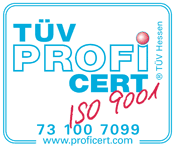
Project management
Preparation covers taking various measures that are intended to prepare the data required for the document concerned.
a) Administrative aspects
We ensure transparency in project processing by registering all translation orders in our software program and documenting the processing status on our master card.
b) Technical aspects
We provide all the necessary technical resources and ensure that the data provided by our customers are prepared for the translation process itself. Preparation can cover different technical measures such as, e.g., sourcing the necessary typefaces or compiling reference material such as terminology collections.
c) Personnel aspects
To meet the expectations of our customers with regard to the realisation of agreed standards we employ qualified staff to handle orders (see also: Our translators). All activities in this respect are recorded.
d) Linguistic aspects
We ensure that our customers' terms of reference for specific linguistic standards for the translation projects are recorded on our form "Job specification". These include, e.g., information on the purpose of the translation, the level of style, or on the use of terminology, as well as terms of reference regarding the adaptation to a specific target group, or the extension of existing glossaries.
We analyse the source text to detect problems that may arise on translation beforehand. This includes the examination of aspects such as text category, text function, structure of nonverbal elements such as graphics or figures, special features in lexis, syntax or grammar.
If projects require a special terminology, where applicable we agree with our customers that terminology work is provided as an additional service.
If customers do not provide their own style rules, we use our own or other suitable guidelines when translating.
Translating a text from the source language into the target language must
be done in such a way that the target text conforms optimally to the
source text with regard to content, intention and style and conforms to the
rules and meets the requirements of the target language.
The following criteria, among others, must be observed:
- Terminology: the terminology to be used is to be agreed with the
customer.
If customers do not have their own terminology collection(s),
the general terminology for the respective specialist field is to be
used, whereby terminological consistency in the whole text must be
guaranteed.
- Grammar, syntax, sentence structures, spelling, punctuation
- Lexical coherence, phraseological correctness
- Style specifications: correct use of the customer's style specifications or
of our style rules
- The conventions and standards that are to be taken into account
- Formatting
- Target group and text function of the translation
a) Initial inspection
After the initial translation is completed, it is the duty of our translators to check their own work for errors, omissions, style, special terms of reference and to correct where necessary.
Once the text has been checked by the translator and submitted, our office carries out an initial inspection with regard to completeness, realisation of given processing criteria, compliance with deadlines and return of all records that are part of the order. Any corrections that are necessary are carried out and missing documents are requested.
b) Intermediate test: proofreading
The translation is now passed to another qualified translator for proofreading. This translator checks whether the respective project specifications were taken into account in the translation and the translation is fit for purpose content-wise and linguistically. Use of consistent terminology is checked, as is the suitability of the linguistic register and style.
If stipulated, the text is checked in the target language to evaluate the accessibility and comprehensibility of the translation from a technical aspect.
With an appropriate agreement a second proofreading can be carried out, as well as galley proofreading of manuscripts.
The suggestions for corrections that arise here are taken into account in any case and appropriate corrective measures are initiated.
c) Final inspection and release
After a final check of whether the product meets all requirements, the management releases the translation and it is delivered to the customer.
The inspection status is documented in all phases of the quality inspection.
Our master card shows clearly that a translation has run through the necessary inspections and conforms to the stipulated criteria.
If value-added services such as certification, localisation, preparation of a terminology database were agreed, we ensure these are supplied on a high quality level as well.









 Back to top
Back to top